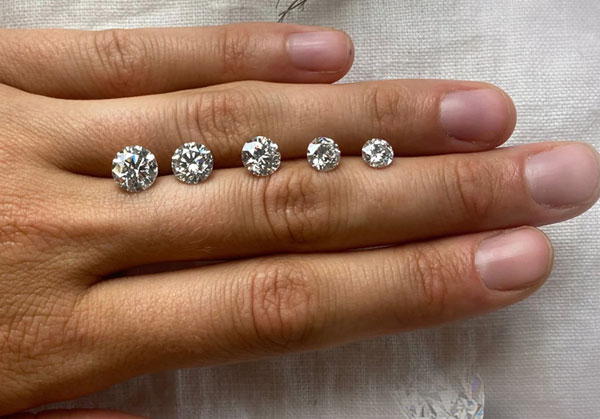What To know About LAB GROWN Diamonds

Lab-grown diamonds came onto the scene in the early aughts. They are more affordable and have less impact on the environment than their natural counterpart. Lab-grown and natural diamonds are identical in in physical and chemical composition. Lab diamonds are created in labs all over the world in just a few weeks while natural diamonds were formed deep within the earth 1 to 3 billion years ago, lending to their beauty as rare gems!
What are Lab-Grown Diamonds?
Lab-grown diamonds, also known as man-made or cultured diamonds, are created in high-tech laboratories using advanced technology that replicates the natural diamond-growing process. These diamonds have the same physical, chemical, and optical properties as earth-mined diamonds—because they’re made of pure carbon, just like their natural counterparts.
Are Lab-Grown Diamonds Real?
Absolutely! Lab-grown diamonds are 100% real diamonds. They’re not cubic zirconia, moissanite, or any diamond simulant. They possess the same hardness, brilliance, and fire as natural diamonds and are graded using the same criteria: cut, color, clarity, and carat weight (the 4 Cs).
Since lab-grown diamonds are grown under controlled conditions, they often show fewer inclusions than natural diamonds, making higher-clarity stones more accessible!
But What About Certification?

Just like natural diamonds, lab-grown diamonds are graded by leading gemological institutions like the Gemological Institute of America (GIA) and the International Gemological Institute (IGI) to ensure quality and authenticity. All SAMA diamonds are independently verified by these institutions. They evaluate and grade diamond quality based on cut, color, clarity, and carat weight (4C’s).

How Can You Tell the Difference Between Lab-Grown and Natural Diamonds?
To the naked eye, lab-grown and natural diamonds look identical. Even professional jewelers need specialized equipment to tell them apart.
Here’s how experts differentiate them:
Inclusions: Lab-grown diamonds may show unique inclusions specific to the manufacturing process (like metallic inclusions in HPHT or growth patterns in CVD).
Fluorescence: Some lab-grown diamonds exhibit stronger fluorescence under UV light.
Laser Inscription: Many lab-grown diamonds are laser-inscribed with a microscopic identifier on the girdle, indicating their origin.
Natural VS Lab-Grown Diamonds
| Feature | Natural Diamonds | Lab-Grown Diamonds |
|---|---|---|
| Origin | Earth’s mantle | Lab-created process |
| Formation Time | Billions of years | 2-12 weeks |
| Composition | 100% carbon | 100% carbon |
| Cost | Higher price point | More affordable |
| Uniqueness | One-of-a-kind | Consistently high quality |
| Resale Value | Higher | Lower |
| Ethics & Environment | Higher impact due to mining | Lower environmental impact |
Price
Lab-grown diamonds are significantly more affordable. Why? This is because the supply chain for lab-grown diamonds is shorter and more efficient, without the high extraction costs associated with mining. Opting for a lab-grown diamond lets you allocate more of your budget to size or quality, giving you a bigger or higher-grade diamond for less!
But what about the resale value? Lab-grown diamonds have a considerably lower resale than natural diamonds. Lab diamonds are produced in a controlled environment, and as technology improves, production costs decrease, driving prices down. There is also plenty of supply to meet demand with little demand for pre-owned lab-grown diamonds, as buyers can often purchase a brand-new one at a lower price. Lab-grown diamonds are an excellent choice for upfront value and affordability but should be viewed more as a beautiful purchase rather than an investment.

How Are Diamonds Made?
Natural (Earth-Mined) Diamonds Natural diamonds are formed 100 miles beneath the earth’s surface under extreme heat and pressure over billions of years. Volcanic eruptions then bring these rough diamonds closer to the surface, where they are eventually mined.
High Pressure High Temperature (HPHT) HPHT diamonds are grown by mimicking the natural diamond-formation process.
Carbon is subjected to temperatures over 1,500°C (2,732°F) and extreme pressure exceeding 1.5 million psi. As the carbon melts, it crystallizes into a diamond over a few weeks.
Chemical Vapor Deposition (CVD) CVD diamonds are lab grown using a different technique:
A diamond seed is placed in a vacuum chamber filled with carbon-rich gases. These gases are heated to high temperatures, causing carbon atoms to bond to the seed layer by layer, forming a diamond crystal over a few weeks.
CVD diamonds often require an HPHT post-growth treatment to enhance color and brilliance.
Pro Tips:
- When deciding between natural and lab-grown diamonds, consider what matters most to you.
- Lab-grown diamonds offer bigger sparkle for your budget. Also, with a lower environmental impact and ethical sourcing, they are a more sustainable option than natural diamonds.



